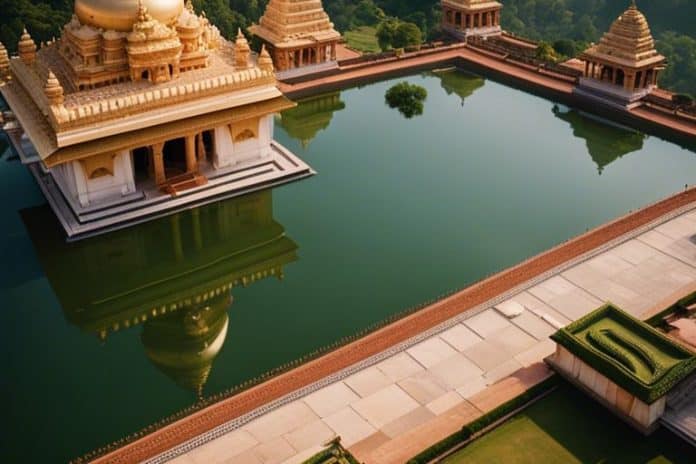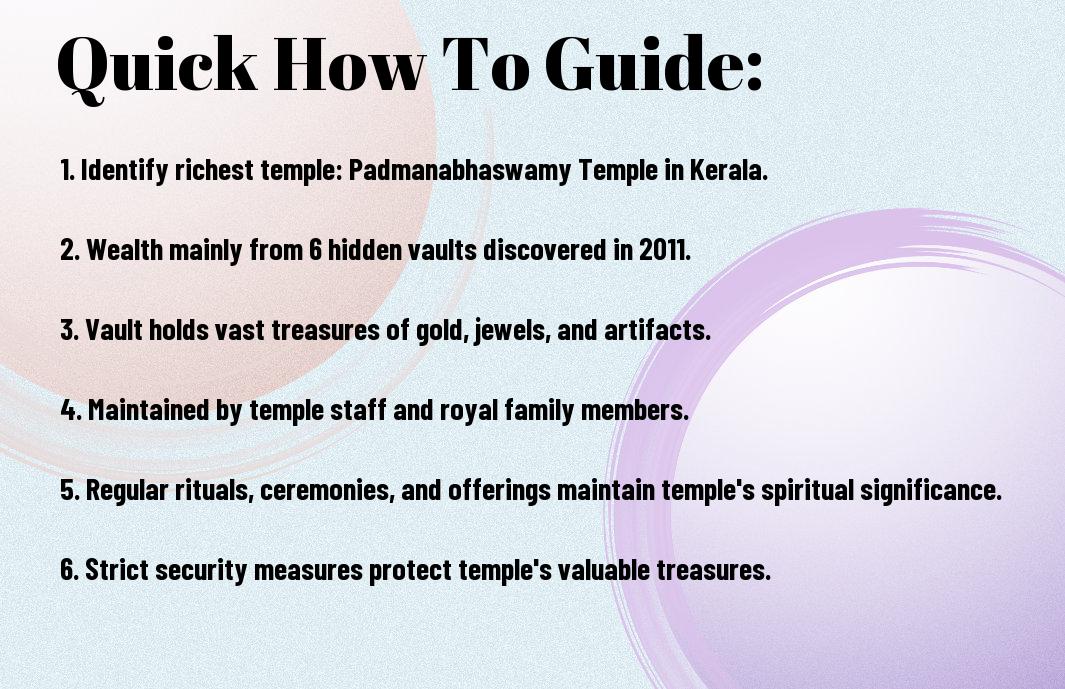Maintenance of religious sites is crucial to uphold their cultural significance and ensure the safety of visitors. Concerning the richest temple in India, Sree Padmanabhaswamy Temple in Kerala holds this esteemed title. The temple is not only a spiritual center but also a treasury of immense wealth and historical artifacts, making its maintenance a task of great importance.
The Sree Padmanabhaswamy Temple houses extraordinary riches, including gold idols, jewelry, and treasures that have been accumulated over centuries. The upkeep of such valuables requires stringent security measures and preservation techniques to safeguard against theft and environmental damage. Additionally, the maintenance of the temple complex itself, with its intricate architecture and sacred spaces, demands skilled craftsmen and conservation experts to ensure its longevity.
Despite its wealth, Sree Padmanabhaswamy Temple relies on donations from devotees and funds from the royal family of Travancore for its maintenance. The temple follows strict rituals and customs, with revenues from ceremonies and offerings contributing to its upkeep. The meticulous care and dedication put into preserving this iconic temple exemplify the deep-rooted spiritual and cultural importance it holds for the people of India.
Key Takeaways:
- The richest temple in India is the Padmanabhaswamy Temple in Kerala, with estimated assets worth billions of dollars.
- The temple’s wealth is managed by a trust, and a Supreme Court ruling strictly controls access to its vaults.
- The temple’s wealth includes gold, jewels, and other treasures, making it one of the wealthiest religious institutions in the world.
- The assets of the temple are believed to be offerings made by devotees over centuries, contributing to its immense wealth.
- The temple’s maintenance is overseen by a team of priests, trustees, and government officials, ensuring its preservation and security.
- The temple follows strict rituals and traditions, attracting millions of pilgrims and tourists from around the world.
- Efforts are continuously made to safeguard the temple’s assets and maintain its cultural significance, making it a symbol of faith and heritage in India.
Unfolding the Enigma: Identifying the Richest Temple in India
Criteria for Wealth Assessment
One of the key criteria for determining the richest temple in India is the sheer value of the assets owned by the temple. This includes not only the wealth in terms of gold, silver, and precious stones but also the land holdings and investments made by the temple over the years. Additionally, the income generated through donations, offerings, and other sources plays a crucial role in assessing the financial strength of a temple.
Another important factor to consider is the number of devotees visiting the temple annually. The higher the footfall, the greater the potential for income through various channels such as ticket sales, prasad offerings, and other activities. Furthermore, the management of resources and funds, as well as transparency in financial dealings, are vital aspects that contribute to the overall wealth status of a temple.
Lastly, the historical and cultural significance of the temple cannot be overlooked. Temples that have a rich heritage, are associated with significant events or legends, and hold a special place in the hearts of devotees are likely to attract more donations and offerings, thereby contributing to their wealth.
Historical and Cultural Significance
Now, delving into the historical and cultural significance of a temple not only enriches its spiritual importance but also adds to its financial value. Temples that are steeped in history, boasting architectural marvels, and housing revered deities tend to draw more devotees and donations.
It is crucial to note that temples often serve as not just religious centers but also as hubs of community activities, social gatherings, and charitable endeavors. This multifaceted role contributes to the upliftment of both spiritual and societal well-being, making temples integral to the fabric of Indian society.
The Vault of Prosperity: Shree Padmanabhaswamy Temple
Once again, we probe into the secrets of the wealthiest temple in India, the Shree Padmanabhaswamy Temple. Situated in Thiruvananthapuram, Kerala, this temple is renowned for its opulence and mystique. The temple is dedicated to Lord Padmanabhaswamy, a form of Lord Vishnu reclining on the divine serpent Anantha. The history of this sacred place is steeped in legends and traditions, dating back centuries.
Historical Background of Shree Padmanabhaswamy
An integral part of the Travancore Royal Family, the Shree Padmanabhaswamy Temple has been an enduring symbol of power and wealth. The temple’s origins can be traced back to the 8th century, with contributions and expansions made by various rulers over the centuries. The Travancore kings, in particular, played a significant role in enhancing the temple’s grandeur and prestige. The temple’s architecture reflects a blend of Kerala and Dravidian styles, with intricate carvings and towering gopurams.
The temple’s legacy is also intertwined with the wealth found within its vaults. Stories of hidden chambers filled with treasures beyond imagination have captured the public’s fascination. The temple gained international attention in 2011 when several vaults were opened, revealing a staggering hoard of gold, jewels, and antique artifacts. This unprecedented discovery catapulted the temple into the spotlight, raising questions about the extent of its riches and the responsibility of managing such wealth.
Unraveling the Wealth: Exploring the Hidden Treasures
On the path to uncovering the temple’s hidden treasures lies a journey shrouded in mystery and intrigue. Legend has it that there are multiple vaults within the temple, each safeguarding priceless possessions accumulated over centuries. The process of cataloging and assessing the wealth is a meticulous endeavor, requiring expertise and caution. The treasures within the vaults are not just material riches but cultural and historical artifacts that offer insights into the region’s heritage and legacy.
The management of the wealth housed within the Shree Padmanabhaswamy Temple is a herculean task that comes with both blessings and challenges. The responsibility of preserving such vast riches while ensuring transparency and security is a delicate balancing act. With the temple’s wealth attracting pilgrims and tourists from around the world, the spotlight on its management practices has never been more intense. Efforts to maintain the sanctity and historical significance of the temple while harnessing its prosperity for the greater good require a fine-tuned approach that honors tradition and embraces modernity.
How-to Uncover the Sources of Temple Wealth
Devotee Contributions and Donations
Keep in mind that one of the primary sources of wealth for temples in India is the contributions and donations made by devotees. Devotees often make offerings in the form of money, gold, silver, precious stones, and other valuables as a gesture of their faith and devotion. These donations can accumulate over time and significantly contribute to the overall wealth of the temple.
Assuming that the temple has a strong devotee base, it is important to track and manage these contributions effectively. Temples often have dedicated administrative staff who oversee the collection and recording of donations. Additionally, some temples have advanced systems in place to ensure transparency and accountability in managing devotee contributions.
It is crucial for temples to maintain a healthy relationship with their devotees to continue receiving contributions. Many temples also organize events and fundraisers to encourage donations and foster a sense of community among devotees.
Accumulated Wealth Over Centuries: Exploring Historical Contributions
For centuries, temples in India have accumulated wealth through historical contributions from royal families, wealthy merchants, and affluent individuals. These contributions could include land grants, precious artifacts, jewelry, and other valuable assets that were gifted to the temples by kings and noble families as a mark of their piety and devotion.
For temples, the historical contributions play a significant role in shaping their current financial status and influence in society. Over time, some temples have become repositories of wealth and treasure, showcasing the artistic and cultural legacy of the regions they are located in.
Government Grants and Royal Patronage
Wealth is also accrued by temples through government grants and royal patronage. In the past, rulers and emperors would extend their support to temples by providing financial assistance, land grants, and resources for the upkeep and maintenance of the temple premises. These grants and patronage helped temples flourish and expand their influence.
Government grants and royal patronage have been instrumental in preserving the cultural and architectural heritage of temples in India. They have also played a crucial role in sustaining the economic stability of temples in the face of changing times.
Tips for Effective Management of Temple Finances
All temples, regardless of their size or popularity, need to have a solid financial management strategy in place to ensure sustainability and growth. Here are some tips to effectively manage temple finances:
- Establish Transparent Financial Practices: Transparency is key when managing temple finances. Ensure that all financial transactions are documented and easily accessible to stakeholders. Implement clear accounting procedures and conduct regular audits to maintain accountability.
- Role of Temple Trusts and Administrative Bodies: Temple trusts and administrative bodies play a crucial role in overseeing the financial affairs of the temple. They are responsible for creating and implementing financial policies, managing budgets, and ensuring compliance with regulatory requirements.
- Technological Advancements in Financial Management: Embracing technological advancements can streamline financial management processes in temples. Utilize software solutions for accounting, budgeting, and donation tracking to improve efficiency and accuracy.
Establishing Transparent Financial Practices
Any temple looking to effectively manage its finances must prioritize transparency in its financial practices. By maintaining thorough records of all financial transactions, the temple can build trust with its stakeholders and ensure accountability. Conducting regular audits and implementing clear accounting procedures will further establish transparency and help prevent any financial discrepancies.
Temple administrators should also communicate financial information openly to the temple community, fostering a culture of transparency and encouraging active participation in financial matters. By involving stakeholders in financial decisions and providing them with accessible information, the temple can ensure that its financial practices reflect the values and beliefs of its supporters.
After establishing transparent financial practices, the temple can enhance its reputation as a trustworthy institution dedicated to proper financial stewardship.
Role of Temple Trusts and Administrative Bodies
For effective financial management, temple trusts and administrative bodies must work in coordination to oversee the temple’s financial affairs. These entities play a pivotal role in formulating financial policies, creating budgets, and ensuring compliance with legal and regulatory requirements.
Temple trustees and administrators should have a clear understanding of their fiduciary responsibilities and act in the best interests of the temple and its followers. By upholding ethical standards and maintaining financial discipline, they can safeguard the temple’s resources and promote its long-term sustainability.
Practices that prioritize the temple’s financial well-being are important for maintaining the trust and support of the community and ensuring that the temple remains a beacon of spiritual and cultural significance.
Technological Advancements in Financial Management
One of the key ways temples can enhance their financial management practices is by leveraging technological advancements. Implementing software solutions for accounting, budgeting, and donation tracking can streamline financial processes and improve accuracy in financial reporting.
Role of technology not only boosts efficiency but also ensures greater transparency in financial transactions. Whether managing donations, tracking expenses, or generating financial reports, technological tools can provide temple administrators with the necessary resources to make informed financial decisions and sustain the temple’s operations effectively.
The Factors Influencing the Maintenance of the Temple’s Wealth
Unlike regular businesses or institutions, temples in India do not generate revenue through sales or services. They rely solely on donations and offerings from devotees to maintain their wealth. The management of a temple’s finances is crucial to ensure its sustainability and continued prosperity. Several factors influence how a temple’s wealth is preserved and utilized effectively.
- Donations and Offerings: The primary source of income for temples, donations and offerings play a significant role in determining the financial health of a temple. Devotees contribute money, gold, jewels, and other valuables as a form of piety and devotion. Managing and recording these contributions accurately is important to ensure transparency and accountability.
- Investment Strategies: Some temples invest their wealth in assets such as land, properties, and businesses to generate additional income. Investment decisions must be made wisely to protect the temple’s wealth and ensure long-term financial stability.
- Legal and Regulatory Compliance: Temples must adhere to financial regulations and laws to prevent any misuse of funds or assets. Regular audits and financial reporting help maintain transparency and uphold the temple’s reputation.
After understanding the factors that influence the maintenance of a temple’s wealth, it is evident that a strategic approach is required to ensure financial sustainability and the preservation of the temple’s assets. To explore more about India’s richest temples and their net worth, check out India’s richest temples and their net worth! – Times of India.
Preservation of Treasure Troves
The preservation of treasure troves within temples involves safeguarding valuable assets such as gold, jewels, and ancient artifacts. Proper storage facilities, security measures, and regular inventories are important to protect these treasures from theft or damage. Additionally, ensuring that these assets are well-maintained preserves their historical and cultural significance for future generations.
Managing the Inflow of Monetary and Non-monetary Offerings
For temples, managing the influx of monetary and non-monetary offerings is a delicate balancing act. While financial contributions are important for the temple’s operations and maintenance, non-monetary gifts such as food, clothes, and services also play a vital role in supporting the temple community. Creating systems to efficiently process and utilize these offerings ensures that the temple can meet the needs of its devotees while maintaining financial sustainability.
For instance, temples often have separate accounts for monetary and non-monetary offerings to ensure transparency and proper allocation of resources. Regular assessments of the temple’s needs and priorities help in effectively managing these contributions for the benefit of the temple and its community.
Security Measures and Insurance
An integral part of safeguarding a temple’s wealth involves implementing robust security measures and insurance policies. With valuable assets and a constant flow of donations, temples are vulnerable to theft, fraud, and other risks. Security systems, including surveillance cameras, alarms, and security personnel, help deter potential threats and protect the temple’s wealth.
Temples may also opt for insurance coverage to mitigate financial losses in case of unforeseen events such as natural disasters or accidents. Insuring valuable assets and implementing risk management strategies are crucial steps in safeguarding the financial well-being of temples.
How-to Foster Sustainable Temple Economy while Maintaining Traditions
Balancing Tourist Interests with Sacred Practices
Despite the influx of tourists to India’s richest temples, it is crucial to maintain a delicate balance between catering to the needs of visitors and preserving the sacred traditions of the temple. Any changes implemented for tourism must not compromise the spiritual sanctity of the place. This can be achieved by creating designated tourist areas within the temple premises while ensuring that the core practices and rituals remain undisturbed.
Efforts should be made to educate tourists about the cultural significance and religious practices observed at the temple. By promoting responsible tourism, visitors can be encouraged to respect the norms and values of the sacred place. Any commercial activities within the temple vicinity should be regulated to prevent exploitation of the religious sentiments of the devotees.
Temple authorities must collaborate with tourism boards and local authorities to develop sustainable tourism models that benefit the community while safeguarding the ancient traditions of the temple. Any development plans should be executed with careful consideration for the spiritual impact on the temple and its surroundings.
Ecological Conservation Efforts around Temple Vicinity
One of the key aspects of maintaining a sustainable temple economy is implementing ecological conservation efforts in and around the temple premises. One approach is to create green zones within the temple compound that promote biodiversity and sustainability. Planting native trees and setting up water conservation measures can help preserve the natural ecosystem.
Ecological conservation efforts should extend beyond the temple boundaries to protect the surrounding environment. Initiatives such as waste management systems, renewable energy installations, and eco-friendly practices can contribute to reducing the carbon footprint of the temple. By raising awareness among devotees and visitors, a culture of environmental responsibility can be fostered.
Collaborating with local environmental organizations and government agencies can further enhance these conservation efforts. By actively engaging in initiatives such as tree planting drives and clean-up campaigns, the temple can demonstrate its commitment to environmental stewardship and inspire positive change in the community.
Community Development Initiatives
An important aspect of maintaining a sustainable temple economy is investing in community development initiatives that empower the local population. By providing skill development programs, educational opportunities, and healthcare services, temples can contribute to the overall well-being of the community. An inclusive approach that involves the participation of local stakeholders is imperative for the success of such initiatives.
Furthermore, temples can support local artisans and craftsmen by promoting traditional handicrafts and cultural heritage. By creating market spaces within the temple premises for these artisans to showcase their products, an avenue for sustainable livelihoods can be established. This not only preserves the rich cultural heritage of the region but also boosts the local economy.
Temple authorities can also partner with non-profit organizations and social enterprises to address social issues such as poverty alleviation, women’s empowerment, and healthcare access. By leveraging the spiritual and social capital of the temple, an impactful difference can be made in the lives of the local community members.
By implementing these sustainable strategies and initiatives, temples can uphold their sacred traditions while fostering a thriving economy that benefits both the temple and the surrounding community. Embracing a holistic approach that balances economic development with cultural preservation and environmental conservation is imperative for the long-term sustainability and prosperity of India’s richest temples.
Legal Framework and Policies in Maintaining Temple Wealth
The Role of Indian Judiciary and Legal Provisions
For centuries, Indian temples have held vast amounts of wealth in the form of gold, silver, precious stones, and land, making them significant contributors to the country’s economy. The management of temple wealth is governed by a mix of religious customs, traditional practices, and legal frameworks. Little state intervention was seen historically in the management of temple assets. However, with growing concerns over transparency and accountability, the Indian judiciary has played a crucial role in ensuring the proper maintenance and utilization of temple wealth.
Indian courts have stepped in to monitor the financial activities of temples, particularly in cases where mismanagement or corruption is suspected. The judiciary has also given judgments to protect temple assets from encroachment or illegal possession. Additionally, the government has enacted laws such as the Charitable Endowments Act and the Religious Institutions (Prevention of Misuse) Act to regulate the administration of temple wealth and prevent its misuse.
With the increasing scrutiny on temple finances, there is a growing emphasis on establishing clear guidelines and regulations to govern the management of temple wealth. The involvement of the Indian judiciary has been instrumental in setting these standards and ensuring compliance with legal provisions to safeguard the interests of devotees and protect the heritage value of temples.
Governing Regulations and Compliance Requirements
Wealth management of temples in India is subject to strict regulations that aim to promote transparency, accountability, and responsible stewardship of assets. Temples are required to maintain detailed records of their financial transactions, assets, and expenditures. Compliance requirements include conducting regular audits, seeking government approval for major financial decisions, and adhering to guidelines on income tax exemptions for charitable donations received.
Non-compliance with these regulations can result in legal action, including fines, seizure of assets, or even criminal prosecution. The stringent oversight is intended to prevent any misuse or misappropriation of temple funds and ensure that resources are utilized for the benefit of the community and the preservation of religious institutions.
Temple administrations are also encouraged to adopt best practices in financial management and governance to enhance efficiency and effectiveness in utilizing their wealth for religious, social, and charitable purposes. The implementation of robust compliance mechanisms is vital to maintaining public trust and upholding the sanctity of temple wealth.
International Perspectives on Wealth Management of Places of Worship
The management of wealth in places of worship is not unique to India but is a global phenomenon. International perspectives on overseeing the financial affairs of religious institutions vary, with some countries adopting stringent regulatory frameworks while others rely more on self-regulation within religious communities. Transparency and accountability are common themes across different jurisdictions, with a focus on ensuring that religious assets are used for their intended purposes and serve the public good.
In countries with a rich heritage of religious monuments and temples, there is a growing recognition of the need to strike a balance between preserving cultural heritage and promoting sustainable financial management practices. Collaboration between governments, religious leaders, and stakeholders is necessary to develop policies that safeguard the wealth of places of worship while respecting religious autonomy and traditions.
Learning from international experiences can offer valuable insights for India in enhancing the governance of temple wealth and ensuring its responsible stewardship for future generations. By benchmarking against global best practices and adapting regulations that suit the Indian context, the country can strengthen its efforts to protect and sustain the rich cultural and spiritual legacy embodied in its temples.
Insightful Tips for Long-term Conservation of the Temple’s Riches
Now, when it comes to maintaining the riches of the richest temple in India, it is necessary to implement strategies that ensure long-term conservation. By following these tips, the temple can safeguard its assets for future generations.
Regular Audits and Valuation of Temple Assets
Temples should conduct regular audits to assess the value of their assets, including gold, silver, precious stones, and other valuable items. By having a clear understanding of the temple’s wealth, the management can take necessary measures to protect and preserve these treasures. Consistent valuation also helps in updating records and insurance policies, ensuring adequate coverage for any unforeseen events.
Moreover, by involving independent auditors and experts in the valuation process, temples can gain valuable insights into the market trends and potential risks. This proactive approach allows the temple management to make informed decisions regarding the financial management of the assets. Additionally, regular audits help in detecting any discrepancies or discrepancies in the temple’s inventory, enabling prompt action to rectify the issues.
Assume that the temple follows a strict schedule for conducting audits and valuations, adhering to industry best practices and standards to maintain transparency and accountability in asset management. This systematic approach ensures that the temple’s riches are effectively preserved and protected.
Engaging with Historians and Conservation Experts
There’s immense value in collaborating with historians and conservation experts to gain insights into the historical significance and preservation techniques of the temple’s assets. By tapping into their expertise, the temple management can develop informed conservation strategies that balance tradition with modern preservation methods. Historians can provide valuable context and understanding of the cultural and historical importance of the temple’s riches, guiding conservation efforts accordingly.
This collaborative approach also facilitates the sharing of knowledge and best practices in preservation and restoration techniques. By engaging with experts in the field, the temple can benefit from cutting-edge technologies and methodologies to ensure the long-term sustainability of its assets. Together, historians and conservation experts can work towards a common goal of preserving the legacy of the temple for future generations.
Educational Outreach and Global Collaboration
Conservation efforts can be further strengthened through educational outreach programs that raise awareness about the importance of preserving cultural heritage. By engaging with local communities, schools, and universities, the temple can instill a sense of pride and ownership in safeguarding its riches. Collaborating with global institutions and organizations can also enhance the temple’s conservation initiatives by leveraging international expertise and resources.
With a focus on education and collaboration, the temple can create a network of supporters and partners dedicated to the long-term preservation of its assets. By fostering global connections, the temple not only enhances its conservation efforts but also promotes cultural exchange and mutual understanding on a worldwide scale.
The Road Ahead: How to Envision the Temple’s Future
Innovations in Revenue Generation for Temple Maintenance
Not all temples in India rely solely on donations from devotees for their maintenance. In recent years, there have been innovative approaches implemented to generate revenue and ensure the upkeep of these sacred sites. Some temples have started offering premium darshan services for a fee, allowing devotees to bypass long queues and receive special blessings. Others have opened up their premises for events and weddings, creating an additional source of income. These initiatives have not only helped in maintaining the temples but also in enhancing the overall visitor experience.
Temples have also embraced technology to streamline their operations and reach a wider audience. Online donation platforms, virtual tours, and e-commerce stores selling temple merchandise are becoming increasingly popular. By leveraging digital tools, temples can engage with donors and devotees in new ways while generating additional revenue. These innovative approaches not only ensure the financial sustainability of the temples but also help in preserving their cultural and historical significance for future generations.
Furthermore, some temples have diversified their income streams by investing in the stock market, real estate, or setting up educational institutions. By judiciously managing their assets and exploring new avenues for revenue generation, temples can secure their financial future and continue to serve as centers of spirituality and community for years to come.
Debating Ethical Considerations in Display and Utilization of Wealth
With the accumulation of wealth in temples, questions have been raised about the ethical considerations surrounding the display and utilization of these riches. While some argue that temples should showcase their wealth as a sign of prosperity and divine blessings, others believe that excessive opulence goes against the principles of humility and service espoused by many faiths. The debate over whether temples should hoard their wealth or redistribute it for the welfare of the community is an ongoing one.
With the rise of transparency and accountability expectations, temples are facing increasing scrutiny over their financial management practices. It is necessary for temple authorities to strike a balance between honoring their traditions and meeting the evolving needs of their devotees and society. By engaging in open dialogue and ethical reflection, temples can navigate these complex issues and ensure that their wealth is utilized in a manner that aligns with their spiritual values and societal responsibilities.
Preparing for Future Challenges: A Strategic Approach
For temples to thrive in the future, they must adopt a strategic approach to overcome potential challenges. Rapid urbanization, environmental degradation, and changing demographics can all impact the sustainability of temples. By investing in infrastructure upgrades, disaster preparedness, and community engagement initiatives, temples can safeguard their long-term viability. Embracing sustainable practices and adapting to technological advancements will also be crucial in staying relevant and resilient in the face of these challenges.
Considerations such as heritage conservation, cultural preservation, and social welfare should guide the strategic decisions of temples as they plan for the future. By proactively addressing these considerations and fostering collaborations with stakeholders, temples can not only preserve their legacy but also continue to serve as beacons of spirituality and community for generations to come.
To wrap up
Considering all points discussed, we can conclude that the Padmanabhaswamy Temple in Thiruvananthapuram is the richest temple in India. This ancient temple is estimated to hold wealth worth billions of dollars in the form of gold, jewels, and other treasures. The temple’s immense riches have made it a subject of fascination and intrigue for people around the world.
To maintain this incredible wealth, the management of the Padmanabhaswamy Temple follows stringent security measures and protocols. The treasures are carefully cataloged and stored in underground vaults, with access restricted to a select few. Additionally, regular audits and inspections are conducted to ensure the safety and security of the temple’s assets.
Overall, the Padmanabhaswamy Temple stands as a testament to India’s rich cultural and religious heritage. The meticulous preservation and maintenance of its treasures serve as a reminder of the temple’s significance and the devotion of its followers. As one of the most revered temples in the country, the Padmanabhaswamy Temple continues to attract pilgrims and tourists alike, drawn not only by its immense wealth but also by the spiritual serenity it offers.
FAQ
Q: What is the richest temple in India?
A: The Padmanabhaswamy Temple in Thiruvananthapuram, Kerala, is considered the richest temple in India.
Q: How is the wealth of Padmanabhaswamy Temple determined?
A: The wealth of Padmanabhaswamy Temple is believed to be determined by the treasures found in its underground vaults, which were discovered in recent years.
Q: How is Padmanabhaswamy Temple’s wealth maintained?
A: The wealth of Padmanabhaswamy Temple is maintained by a trust that oversees the temple’s operations and manages its assets.
Q: How is the temple’s wealth used for maintenance and development?
A: The wealth of Padmanabhaswamy Temple is used for the maintenance of the temple premises, conducting rituals, festivals, and charitable activities, as well as for the development of the surrounding community.
Q: Who is responsible for managing the affairs of Padmanabhaswamy Temple?
A: The affairs of Padmanabhaswamy Temple are managed by a board of trustees and overseen by the Travancore royal family.
Q: Are there any controversies surrounding the wealth of Padmanabhaswamy Temple?
A: Yes, there have been controversies and legal battles surrounding the ownership and management of the wealth found in the temple’s vaults.
Q: How can visitors contribute to the maintenance of Padmanabhaswamy Temple?
A: Visitors can contribute to the maintenance of Padmanabhaswamy Temple by making donations, participating in temple activities, and supporting the charitable initiatives of the temple trust.




